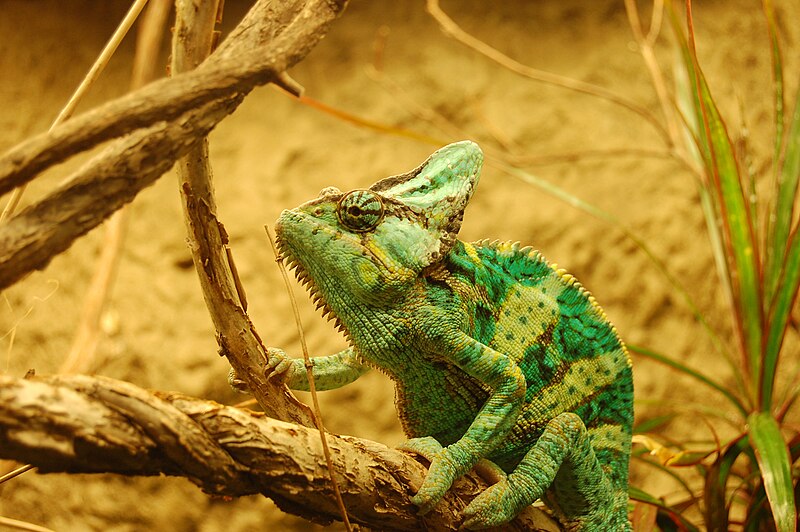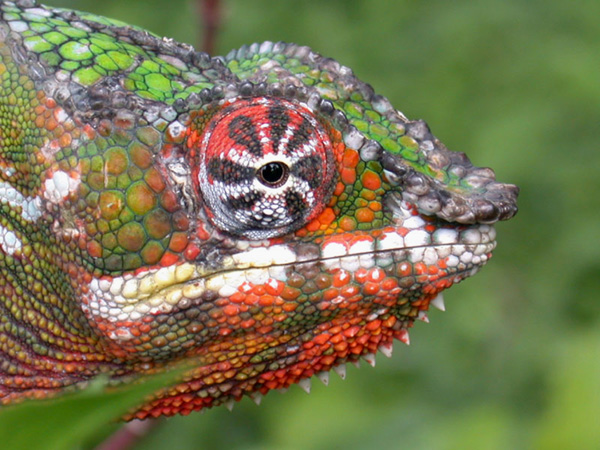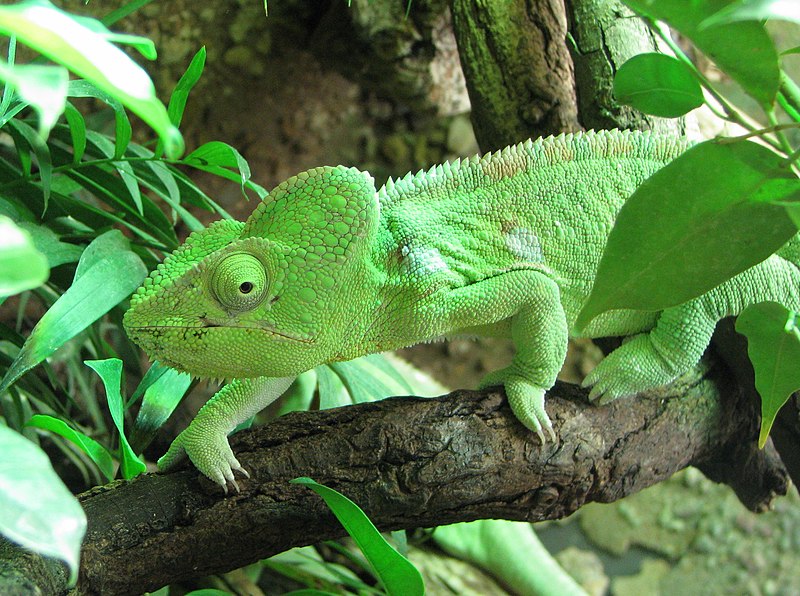
Chameleons Do Not Like Company – Human or Otherwise!
Wolverines and Tasmanian Devils are more sociable than the average chameleon! Highly territorial, both males and females will fight among themselves and with the opposite sex. Pairs may get along in large, heavily-planted enclosures, but they must be watched closely.
Chameleons abhor handling, and are best considered as animals to observe only. Don’t worry, for when properly kept, chameleons will reward you by exhibiting fascinating behaviors…but this will not be the case if you disturb them with unnecessary handling!
Chameleons are Easily Stressed, but Often Appear Content
Here we come to one of the most important and misunderstood concepts in chameleon husbandry. Chameleons are slow-moving and instinctively freeze or drop to the ground when threatened. They are easy to grab and often remain in place when deposited on an arm or shoulder, leading us to believe that all is well.
Some individuals may react to handling by changing color or gaping, but they do not snap, thrash about, run off, or drop their tails as do many other lizards. Inexperienced owners often misinterpret the lack of vigorous protest as an “acceptance” of handling. However, be assured that your pet’s stress hormones are surging, and that this will have a deleterious effect on its immune system and health.
Being relatively inactive, chameleons may seem blissfully unaware of what is going on outside their cages. Again, their reliance on camouflage limits overt signs of agitation. However, they have keen eyesight and miss nothing; indeed, the mere sight of a dominant individual can stress others, even if the animals are housed separately.
Chameleons Need a Highly-Varied Diet
 No chameleon will thrive on a diet comprised of 2-3 insect species…even if all food items are nutrient-loaded and powdered with supplements. I’ve done well by relying heavily upon wild-caught invertebrates. Moths, butterflies, beetles, grasshoppers, tree crickets, katydids, harvestmen, earwigs, “smooth” caterpillars and a variety of others are accepted (far more enthusiastically than crickets!) by all. Please see these articles for tips on collecting insects.
No chameleon will thrive on a diet comprised of 2-3 insect species…even if all food items are nutrient-loaded and powdered with supplements. I’ve done well by relying heavily upon wild-caught invertebrates. Moths, butterflies, beetles, grasshoppers, tree crickets, katydids, harvestmen, earwigs, “smooth” caterpillars and a variety of others are accepted (far more enthusiastically than crickets!) by all. Please see these articles for tips on collecting insects.
Useful commercially-available insects include roaches, crickets, butterworms, super mealworms, caliworms, silkworms, hornworms and locusts. Feeders should be provided a healthful diet before use. Canned grasshoppers, snails, and silkworms may be offered via feeding tongs. Please see this article for further information.
Chameleons Need Large, Well-Ventilated Cages
Despite being relatively sedentary, chameleons need lots of space and plentiful sight barriers, and are stressed by small, bare cages. Specific requirements vary by species and individual, but be prepared for surprises. I’ve had Parson’s and Oustalet’s Chameleons that remained ill at ease until relocated to room-sized exhibits. In fact, some chameleon fanciers dedicate entire rooms of their homes to a pair, or even an individual. Ample climbing space and ventilation is also critical to their well-being.
Custom-made cages, commercial screen terrariums and modified bird aviaries, stocked with branches, vines and live plants, are among the best options for captive chameleons. Heavy plant cover will put your chameleon at ease, and you’ll see more of interest than would be the case in a bare enclosure.
Avoid Wild-Caught Chameleons

Wild-caught chameleons are usually plagued by a variety of health concerns, including dehydration, depressed immune systems, parasites, retained eggs, malnutrition and shipment-related injuries. Please see this article, and be sure to purchase only captive-bred animals.
Please check out my posts on Twitter and Facebook. Each day, I highlight breaking research, conservation news and interesting stories concerning just about every type of animal imaginable. I look forward to hearing about your interests and experiences as well, and will use them in articles when possible.
Please also post your questions and comments below…I’ll be sure to respond quickly.
Thanks, until next time,
Frank Indiviglio
Further Reading
Video: Belalanda Chameleon Conservation
Senegal and Smooth Chameleon Facts
Chameleon Conservation Overview
Chameleons and Camouflage: new findings
Veiled Chameleon image referenced from wikipedia and originally posted by FF23-fr
Furcifer oustaleti image referenced from wikipedia and originally posted by Dragus
Panther Chameleon image referenced from wikipedia and originally posted by Tom Junek
 That Reptile Blog – Reptile, Amphibian and Exotic Pet Care and Information
That Reptile Blog – Reptile, Amphibian and Exotic Pet Care and Information



Another great article, Frank.
I have a female Chamaeleo calyptratus. She is lots of fun. Live planted enclosure, lots of food varieties, including live caught house flies, and lots of love.
She enjoys eating out of my hand, but I also free feed her too.
Thanks for the info !!
Thanks for the kind words, Scott,
A Happy , healthy new year to you and yours, Frank